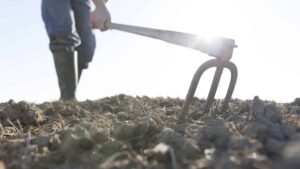There’s a revolution going on in the ground below us. A growing group of passionate farmers have been experimenting with complex combinations of cover crops seed species which may have as much influence as cash crops on the future of sustainable farming. Have plant biologists kept up with these pioneers? Could species be bred to provide better cover crop soil results?
A cover crop is any vegetation grown outside of the growing season or apart from the main crops to provide cover that protects the soil. As any farmer will tell you, their soil is the most important asset they have. Pioneers in the last decade have shown how it is not just necessary to prevent soil loss, but also to develop biota, rejuvenate biodiversity, “sweeten” the soil and literally grow the earth. Weeds, pests and disease can be managed with the correct cover varieties. Cover crops are also increasing yields. Together with no-till farming, this revolution has become known as “conservation agriculture”.
The benefits of conservation agriculture are many. By protecting and developing the soil, farmers are protecting their land from wind and water erosion. Water tables are protected as runoff is reduced, the soil becomes richer, more porous and penetrable. As soils are fed a wide variety of nutrients, organic matter increases, nitrogen levels improve, and farmers can fertilise less. With less tillage, more CO2 is sequestered in the soil and less diesel emissions are released into the atmosphere.
For this article, I interviewed eight farmers about how they cover, what their issues are and what they would like to see from plant breeders to help them take cover.
What seeds are best for cover?
While some farmers would say: “the more seed variety, the merrier”, others want to have deep rooting plants, fibrous roots and those that can survive into colder weather. Time and cost are important. If farmers are planting covers in August, a larger investment may be justified. A faster growing plant that has a quick uptake is important if farmers can’t manage to seed until well into the autumn. Strategy also varies if cover is combined with manure.
As farmers get better at combining cover crop species, some, like Jake Freestone, vary seed varieties according to the next crop in rotation (or if there is certain weed targeting or companion cropping planned). Jake was involved with the NIAB and Kellogg’s Origins project assessing farmer trials in cover crops. They produced a ‘cookbook’ style menu cataloguing the strengths and weaknesses of the different cover species entitled: Cover Crops: A practical guide to soil and system improvement, 2016/17.
The challenges
Slugs. In cooler climates, cover crops can create a green bridge allowing slugs to proliferate (creating the costly necessity to apply slug pellets). Several farmers want breeders to focus on creating cover plants that are less tasty for slugs.
A contrary concern has been planting cover in drought conditions (not only for failure to uptake, but also the risk of further exacerbating water tables should plant cover be insufficient).
There has not been much coordination between researchers and the farming pioneers I’ve interviewed. In some cases, farmers admitted the researchers were focused on one species or type of cover, trying to isolate it from all of the other variables farmers were facing.
What is the perfect cover seed?
Farmers are more concerned about stronger roots than tops, letting in more light and less flower. A fibrous root helps open the soil, increase organic matter and promote biota. It’s about creating a “below-ground biomass”. Certain crops might work as vaccines to prepare the soil to better resist diseases. Outside of the slug issue, cover crops should repel pests that may threaten harvests.
Termination is an important topic. As Tom Jewers said: “We don’t want cover crops to become a weed, so ideally, they need to grow rapidly, but never set any seed!”.
George Hosier uses a ten species cover but also enriches the soil by grazing on his cover crops (so an ideal plant should be palatable for sheep and cattle). Frost resistance is important. With a wide mix, George has managed to keep different cover working through the winter.
Some issues
Not everyone agrees on the virtue of cover crops. Any farmer will tell you every soil, every climate, every crop is different. Not every farmer can or needs to use cover crops in the same way – this practice is anything but a one-size-fits-all. Some are blessed with ideal conditions without the need to actively intervene or have mixed farms with ample manure; others with early winters or wet conditions would not benefit very much. A lot more research needs to be done on this subject.
Several farmers raised the issue of the cost of seeds, noting how natural off-season growth (volunteer re-growth) can be sufficient to regenerate soil. Seed merchants often offer complex blends many farmers find unnecessary (some are blending their own). Farmers also need to acquire extra machinery to allow planting through dense cover without disturbing the soil. This is prohibitive for smaller farmers. Then there is the demand on time (usually just after combining) and diesel fuel.
While farmers agree cover crops are beneficial, there is much debate on the “what” and the “how”.
Glyphosate is vital
Complex cover cropping has been made possible with inexpensive glyphosate-based herbicides, allowing an effective termination process once the crops have done their job. Two years ago, I was given a tour of George Hosier’s conservation agriculture farm in England and I was sold on the sustainability of glyphosate. Many farmers standing up for the environmental benefits of conservation agriculture could not imagine the losses to biodiversity should the activists have succeeded in banning the herbicide.
The biggest challenge for cover cropping is the continued regulatory pressure in Europe to ban glyphosate. The organic lobby rejects conservation agriculture as farming with a chemical plough. Organic farmers are not able to protect their soil with multiple seed covers without access to effective herbicides. Since the lobby will not allow organic farmers to use synthetic herbicides, there will likely be more pressure to fully ban glyphosate in the EU.
And that is more pressure than what the soil, farmers and consumers can handle.
**********************
A special thank you to the following farmers for their support in researching this subject: Jake Freestone, George Hosier, David Butler, Tom Jewers, Tom Sewell, Laurent Van Arkel, Marcus Höltkotter and Terry Daynard. Your work for farming has been precious.
For Cover Crops: A practical guide to soil and system improvement, 2016/17, see https://www.c-l-m.co.uk/wp-content/uploads/2017/07/NIAB-TAG-Cover-Crops-A4-guide-lo-res.pdf.












